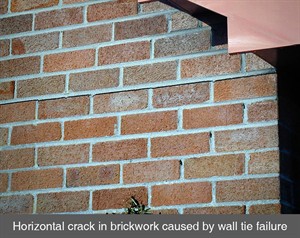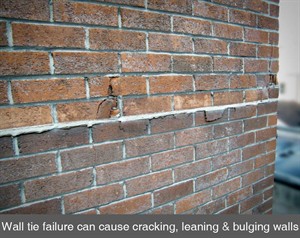Wall Tie Corrosion
 Cracking, bulging and leaning walls can
often be a sign that cavity wall ties have begun to corrode.
In these instances, it is recommended that a comprehensive
survey, inspecting the wall ties, is carried out. Wall
ties in buildings built before 1981, in particular, should have a
visual inspection, checking the corrosion levels of wall ties,
catching them before they become too badly corroded and start
causing visual damage to the structure of the building.
Cracking, bulging and leaning walls can
often be a sign that cavity wall ties have begun to corrode.
In these instances, it is recommended that a comprehensive
survey, inspecting the wall ties, is carried out. Wall
ties in buildings built before 1981, in particular, should have a
visual inspection, checking the corrosion levels of wall ties,
catching them before they become too badly corroded and start
causing visual damage to the structure of the building.
Life Expectancy of Wall Ties
There are different types of wall ties likely to be in a cavity
wall, each with a different life expectancy. Older ties
(pre-mid-1980's) tend to be made from mild steel (eg butterfly
ties, or fishtail ties), which will eventually corrode; the only
question is when. However, it is impossible to know which type of
wall tie is in your cavity wall, and the condition of it, without a
visual inspection.
At Stronghold Preservation, we have experienced surveyors who
are trained to identiify the root cause of the structural problem,
provide a written survey and quotation, and the most suitable
remedial action.
External Symptoms of Corroding Wall Ties
- Corrosion can occur without any obvious external or internal
signs or symptoms. An inspection of any building with cavity wall
ties is therefore essential, in any building built pre 1981.
- Horizontal cracks in masonry walls will often be present,
usually at regular intervals, approximately every five - seven
brick courses.
- Extensive corrosion of cavity wall ties can cause an outward
bulge of the masonry wall, often without any signs of horizontal
cracking
- Window sills may appear to be arching slightly upwards (upward
cambering).
- Window and door lintels may appear to be sagging.
- Horizontal cracking can sometimes be accompanied by stepped
diagonal fracturesof the brickwork, especially at window and door
openings or near the eaves level.
- Lifting of roof edges, especially at gables due to the lifting
effect of the steel expansion on the brickwork.
Internal Symptoms of Corroding Wall Ties
- Horizontal cracks in the walls sometimes become apparent
internally
- Window reveals can separate, as the outer leaf is leaving the
inner leaf behind, particularly at first floor level.
- The lifting and dragging action of the outer leaf can cause
horizontal cracksin walls at the junction of internal walls and
ceilings.
- Another indication of outward movement of external masonry
walls is the separation of floors from skirting boards and
stairs.
- In areas of low deadweight,internal leaf cracking of bed joints
can happen due to the tension developed in the inner leaf.
Determining Tie Conditions
At Stronghold Preservation our surveyors will carry out a visual
inspection of the wall ties by finding the cavity wall tie with a
metal detector, and inspecting the tie within the cavity using an
endoscope. Samples will be inspected at various sites
throughout the building. Should this not be comprehensive
then a brick may be removed to confirm the condition of the ties.
We will provide a detailed written report on the findings of the
survey, along with a competitive quotation for any remedial work
required.
Depending on the level of corrosion as assessed by our
surveyors, we will recommend the most appropriate course of action.
We provide an insurance backed guarantee for all cavity
wall tie replacement work.